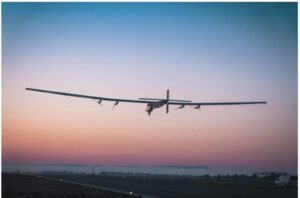SKYDWELLER CONDUCTS AUTONOMOUS FLIGHTS BEFORE U.S. GOVERNMENT TESTS

Marco Vicenzino is global strategy advisor to Skydweller’s CEO
JANE’S DEFENCE WEEKLY
April 25 2023
The Skydweller unmanned aerial vehicle (UAV) is conducting autonomous envelope expansion flights from Albacete, Spain, in anticipation of experimental operations on behalf of US Southern Command (SOUTHCOM), Skydweller Aero CEO Robert Miller told Janes on 19 April. The aircraft has performed nine test flights so far.
On its most recent flight, on 19 March, Skydweller flew for four hours and reached an 18,000 ft altitude. Although a pilot was aboard for safety reasons, the aircraft flew autonomously from start to finish, said Miller.
The eventual goal is an aircraft capable of reaching 45,000 ft altitude and staying aloft for months at a time. “Several more” are planned for June after modifications to the aircraft’s landing gear and airbrake, Miller said, although he declined to reveal a schedule for full envelope expansion.
The lone Skydweller aircraft is a modification of Solar Impulse, the UAV that circled the globe powered only by solar cells and batteries. Two additional aircraft are under construction at partner Leonardo’s factory in Italy. Receipt of those aircraft is uncertain, pending the results of materials testing – the company is replacing the fuselage composites, solar cells, and batteries with more capable versions, “and we have to do some coupon testing before we go to full production on that”, Miller told Janes.
“The main thing in the next aircraft will be a new fuselage because we won’t read the pilot anymore. We’re working with several different battery manufacturers to upgrade the energy density of the battery. And also, we’re looking at the solar cells that are, I would say, a generation or two old,” said Miller.
Battery testing is ongoing at the company’s Madrid, Spain test site, as well as in Oklahoma City in conjunction with Oklahoma State University.
Skydweller Aero is in the process of selecting an operating site on the US Gulf Coast to fly under SOUTHCOM demonstration project. “By late summer we should be doing flights on the Gulf Coast of the US, and then expanding those flights down into the Caribbean later this year,” Miller said. The company has in addition signed a memorandum of understanding (MOU) with Luxembourg and anticipates an award from a French request for quote (RFQ) in the coming months.
The aircraft has seen “significant interest” from other US commands, Miller said, notably Indo-Pacific Command (INDOPACOM) and Africa Command (AFRICOM), where with long distances between airfields and regular needs for persistent surveillance, Skydweller’s long-duration flying may be particularly well suited.
Miller declined to specify what payloads might interest those potential customers but stressed that “Leonardo makes some very good radars, and they build a wide variety of sensors as well”.
Skydweller is intended to have a maximum take-off weight (MTOW) of 2,500 kg and cruising speeds around 30 kt. The UAV features 72 m wings that are covered with 2,900 sq ft of photovoltaic solar cells, which could supply up to 2 kW of power to support its payloads.
Comment:
Skydweller is an ‘atmospheric satellite’: an ultra-long-duration aircraft potentially capable of surveilling an area for months at a time. Although several companies have experimented with similar capabilities, none have yet entered service. Miller estimates the global ‘atmospheric satellite’ market at several hundred aircraft.
